I Sailed Around Komodo National Park on Board an Indonesian-designed Superyacht — and Encountered Giant, Majestic Wildlife
This luxurious sailing vessel charters small-group voyages to visit some of the country’s most remote costal destinations.
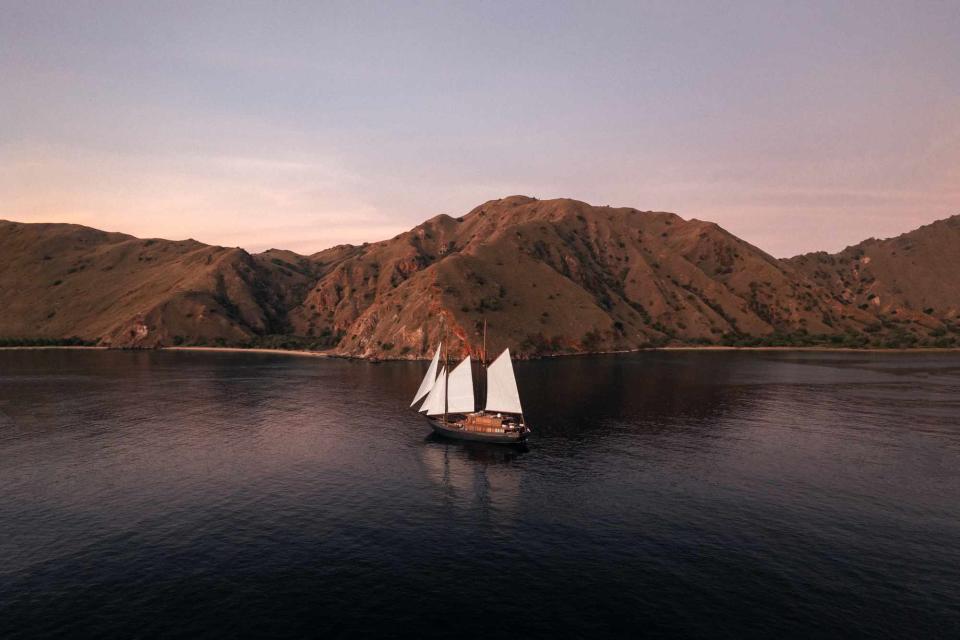
Emilio Kuzma-Floyd/Courtesy of Vela
The Vela enters Batu Moncho Bay, in Komodo National Park.Having grown up with a deep fear of the ocean, my initial reaction after jumping into the bay was, frankly, terror. Salt water flooded my snorkel, making me gag. Below the surface, monumental forms drifted like icebergs. Two whale sharks, the largest fish on the planet, glided around me, their blue-gray skin a Morse code of chalky dots and dashes.
But then my guide, Yoyok Hariawan, took my hand in the water, which instantly calmed me. As we bobbed on the surface together, he pointed out the animals’ distinctively shaped caudal fins, their unexpectedly cartoonish smiles, and their preternatural grace. The two specimens, though juveniles, each measured more than 20 feet in length. As I watched them, my fear faded into quiet awe.
We were floating in the choppy waters near Indonesia’s Komodo National Park in Saleh Bay, one of the best places in the world to see whale sharks up close. One of these magnificent creatures had a weathered satellite transmitter bolted onto its dorsal fin, most likely attached by the nonprofit Conservation International, which started tagging these endangered animals in the country in 2015.
Whale sharks are a mysterious species, and despite tagging efforts like the one we witnessed, much about them, from their breeding habits to their maximum size, remains unknown. Their dark upper bodies and white bellies provide camouflage from both above and below, allowing them to seemingly pop out of nowhere and disappear again.
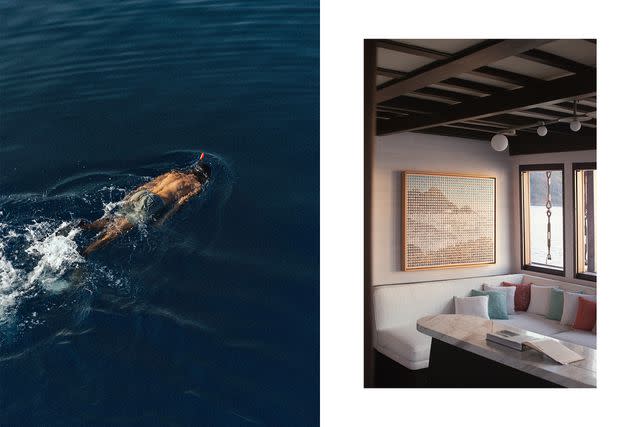
From left: Emilio Kuzma-Floyd/Courtesy of Vela; Tommaso Riva/Courtesy of Vela
From left: A guest snorkels in the waters of Batu Moncho Bay; a work by Javanese artist Dini Nur Aghnia inside Vela's lounge.I was a passenger on the Vela, a luxury sailing yacht that began charting private small-group voyages in August 2022. Its design is based on the wooden phinisi ships once used to transport spices, textiles, and sandalwood around the Malay Archipelago — the world’s largest group of islands, located between Asia and Australia. Vela is a stunning example of Indonesian craftsmanship: built of ironwood and teak by the expert boatbuilders of South Sulawesi’s Konjo tribe, it has six staterooms that can accommodate up to 12 passengers. Its name comes from the constellation Vela the Sails, which is seen mostly in the Southern Hemisphere. (The word vela means “sail” in Latin.)
The ship is owned by Frenchmen Dimitri Tran and Adrien Portier, who also have a sustainable luxury resort, Nirjhara, in southwestern Bali. The vision for Vela, Tran told me, was to combine the features of a modern superyacht with Indonesian design and technique. Those standards also apply to sustainability: Vela was built with extra-large sails to maximize wind power (although there is an engine on board), has dispensed with single-use plastics, and stocks reef-safe amenities like sunscreen and soap.
The 18-person crew, which includes a mixologist and two yoga instructors/massage therapists, most often sails through Komodo National Park and Raja Ampat Marine Park, in eastern Indonesia, but can chart routes to more remote destinations, such as Indonesia’s Alor and Molucca Islands. “We can go anywhere in Indonesia,” said cruise director Dean Noble, whose last trip took travelers to Raja Ampat’s Kali Biru (Blue River) to view its famed birds of paradise.
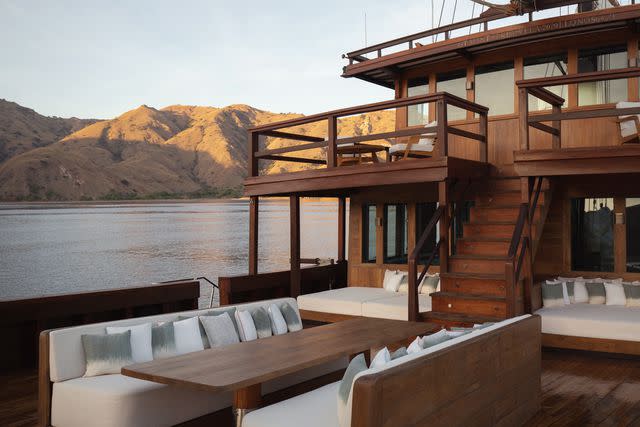
Tommaso Riva/Courtesy of Vela
Vela's main deck.I had boarded Vela for a five-day voyage from Sumbawa to Komodo National Park’s lesser-known corners, a journey of some 220 nautical miles. The park, I learned, is enormous, a 670-square-mile stretch encompassing 29 different islands, including the namesake Komodo, and two bodies of water, the Flores Sea and the Savu Sea.
Inside, the ship is fitted with custom-made, sustainably sourced teak and marble furniture from Bali-based manufacturers and decorated with original works by emerging Indonesian artists. An innovative air-conditioning system uses seawater to keep the rooms cool. Guests have access to an outdoor gym, along with two WaveRunners and two Zodiacs for exploring the coasts and inlets.
I stayed in the luxurious Owner’s Suite, which occupies more than 430 square feet above deck and has its own private terrace. Inside my bathroom, in addition to an oversize bathtub and Balinese tiling in the shower, I found a robe from the East Bali region decorated by hand with plant-based dyes. A 55-inch smart TV with hundreds of movies on demand popped out of a custom console, though I never needed it.
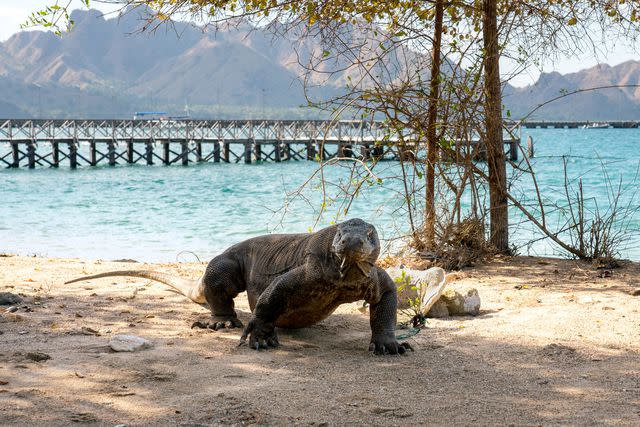
Courtesy of Vela
One of Komodo National Park's famous "dragons".As we sailed east, each day brought more views of verdant islands and blue waters. One afternoon, we swam in Satonda Island’s caldera, a mirror-still saltwater lake ringed with igneous rock, the remnants of an ancient collapsed volcano. At dawn the following morning, we hiked 870 steps up to the peaks of Padar Island, rewarded at the top with sunrise views of the three beaches below, each ringed with a different color sand: white, pink, and black. Another afternoon, we headed to Makassar Reef, a beginner-friendly dive site frequented by green turtles, moray eels, and reef manta rays.
In the water again, I followed Noble’s instructions to stay as still as possible while floating with my snorkel. The balletic rays, some with wingspans as long as sofas, soared close to me. In a truly transcendent moment, one of them circled curiously, then dramatically swooped right under me.
Back on Vela, my wildlife encounters were bookended with sunbathing sessions, in-room massages, inventive cocktails, and delicious meals. Head chef Agus Jayadi widened my palate with superb renditions of local flavors and ingredients, like his smoke-kissed grilled pork satays and precisely cooked line-caught mahi-mahi. I ate beef rendang, a caramelized-meat dish flavored with coconut and spices, and tasted endless aromatic sambals, Indonesian chile pastes.
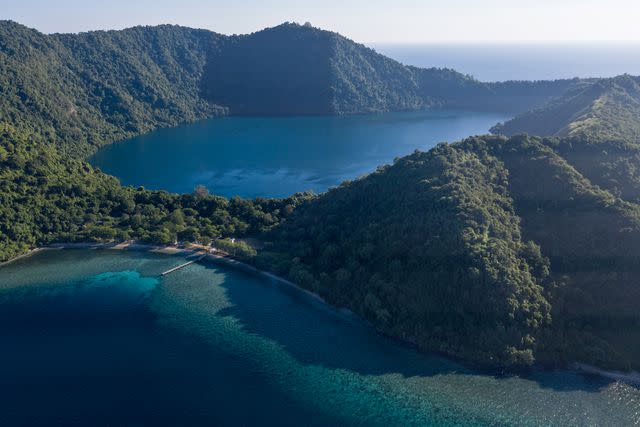
iStockphoto/Getty Images
Vela passengers can swim in the Satonda Caldera, in the Lesser Sunda Islands.On our final afternoon, we cast anchor at Rinca Island to observe the legendary Komodo dragons in their natural habitat. From a raised boardwalk set above a vast, muddy plain, I watched several of the immense reptiles snooze in the late-afternoon heat like lazy dinosaurs. The species, which is endemic to Indonesia, is endangered, but on protected Rinca the population is stable at around 1,400 animals. Our guide, Oji Iskandar, told us that these lizards — the largest and heaviest in the world — can suddenly sprint up to 13 miles an hour in pursuit of prey, and an adult can measure up to 10 feet long.
We sailed away a few hours later, and I thought about the whale sharks, the mantas, and the Komodo dragons. Traveling around eastern Indonesia in hopes of seeing these majestic animals up close wasn’t only about size, I realized. It was about the profound impact the creatures have on every person lucky enough to encounter them. I took it as inspiration to bring home with me — to take up more space and feel a little more wild.
A version of this story first appeared in the September 2023 issue of Travel + Leisure under the headline "In the Wake of Giants."
For more Travel & Leisure news, make sure to sign up for our newsletter!
Read the original article on Travel & Leisure.

